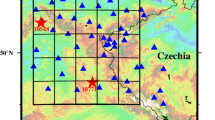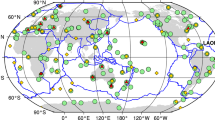Abstract
Although GNSS tropospheric tomography is a powerful tool in meteorology, available validation data limit its accuracy and precision analysis. Moreover, it is customary to accept the validation results as a measure of the model performance. This study shows that this is only possible when the sensitivity of the model elements to the input perturbations is the same. We propose the principal component analysis for studying the sensitivity of a tomography model for this purpose. Our model includes 17 GNSS stations in Northwestern Iran. To analyze the contribution of the applied constraints in the sensitivity results, we use the 3D Gaussian, horizontal, numerical weather prediction model and virtual reference stations (VRS) in our analysis. The results show that some parts of our model are more sensitive to perturbations of input parameters, and therefore, they are more prone to regularization bias. This depends not only on time but also on the applied constraints for computing a unique solution. Results show that the response of our model to input perturbations is considerably different when we use the VRS concept for constraining the model. Using the proposed method and the traditional ways of validating a tomography model, one can develop a lower bound limit for the bias in the sensitive parts of the model and an upper bound limit for the bias in the other parts.







Similar content being viewed by others
Data availability
All datasets used in this study can be obtained from the corresponding author.
References
Adavi Z, Mashhadi-Hossainali M (2014) 4D-tomographic reconstruction of the tropospheric wet refractivity using the concept of virtual reference station, case study: North West of Iran. Meteorol Atmos Phys 125:193–205
Aster R, Borchers B, Thurber C (2005) Parameter estimation and inverse problems, 1st edn. Elsevier Academic Press, New York
Aster R, Borchers B, Thurber C (2019) Parameter estimation and inverse problems, 3rd edn. Elsevier Academic Press, New York
Bender M, Raabe A (2007) Preconditions to ground based GPS water vapour tomography. Ann Geophys 25(8):1727–1734
Bender M, Dick G, Ge M, Deng Z, Wickert J, Kahle H-G, Raabe A, Tetzlaff G (2011) Development of a GNSS water vapour tomography system using algebraic reconstruction techniques. Adv Space Res 47:1704–1720
Bevis M, Businger S, Herring TA, Rocken C, Anthes RA, Ware RH (1992) GPS meteorology: remote sensing of atmospheric water vapor using the global positioning system. J Geophys Res Atmos 97:15787–15801
Böhm J, Niell A, Tregoning P, Schuh H (2006) Global mapping function (GMF): a new empirical mapping function based on numerical weather model data. Geophys Res Lett. https://doi.org/10.1029/2005GL02554
Braun J, Rocken C, Meertens C, Ware R (1999) Development of a water vapor tomography system using low cost L1 GPS receivers. In: Ninth ARM science team meeting proceedings, San Antonio
Brenot H, Rohm W, Kačmařík M, Möller G, Sá A, Tondaś D, Rapant L, Biondi R, Manning T, Champollion C (2020) Cross-comparison and methodological improvement in GPS tomography. Remote Sens 12:30
Chen G, Herring TA (1997) Effects of atmospheric azimuthal asymmetry on the analysis of space geodetic data. Geophys Res 102:20489–20502. https://doi.org/10.1029/97JB01739
Chen BY, Liu ZZ, Wong WK, Woo WC (2017) Detecting water vapor variability during heavy precipitation events in Hong Kong using the GPS tomographic technique. J Atmos Ocean Technol 34:1001–1019
Dief A (1986) Sensitivity analysis in linear systems. Springer
Douša J, Elias M (2014) An improved model for calculating tropospheric wet delay. Geophys Res Lett 41:4389–4397. https://doi.org/10.1002/2014GL060271
Elfving T, Nikazad T, Hansen PC (2010) Semi-convergence and relaxation parameters for a class of SIRT algorithms. Electron Trans Numer Anal 37:321–336
Flores A (1999) Atmospheric tomography using satellite radio signals. Ph.D. Dissertation, Technical University of Catalonia
Guerova G (2003) Application of GPS derived water vapour for numerical weather prediction in Switzerland. Ph.D. Dissertation, University of Bern, Bern
Hanna N, Trzcina E, Möller G, Rohm W, Weber R (2019) Assimilation of GNSS tomography products into the weather research and forecasting model using radio occultation data assimilation operator. Atmos Meas Tech 12(9):4829–4848
Higham NJ (2002) Accuracy and stability of numerical algorithms. SIAM, Philadelphia
Hirahara K (2000) Local GPS tropospheric tomography. Earth Planets Space 52(11):935–939
Jain MK, Iyengar SRK, Jain RK (2003) Numerical methods for scientific and engineering computation. New Age International (P) Limited Publishers, Delhi
Johnson RA, Wichern DW (2002) Applied multivariate statistical analysis. Prentice Hall, Upper Saddle River
Kleijer F (2004) Troposphere modeling and filtering for precise GPS leveling, Delft, The Netherlands
Liou YA, Lin YJ, Chiang CC, Huang CY (2003) Reconstructing 3D wet refractivity structures of the lower troposphere from GPS measurements, In: Proceedings of the GPS-MET conference, Tsukuba, Japan
Mashhadi-Hossainali M (2006) A comprehensive approach to the analysis of the 3D kinematics of deformation. Ph.D. dissertation, Institute of Physical Geodesy, Darmstadt University of Technology, p 152
Nikazad T (2007) The use of Landweber algorithm in image reconstruction. Ph.D. dissertation, Linkopings University, Linkopings
Rohm W, Bosy J (2009) Local tomography troposphere model over mountains area. Atmos Res 93(4):777–783
Rohm W, Bosy J (2011) The verification of GNSS tropospheric tomography model in a mountainous area. Adv Space Res 47:1721–1730
Shafei MJ, Mashhadi-Hossainali M (2020) Application of the GPS reflected signals in tomographic reconstruction of the wet refractivity in Italy. J Atmos Solar Terr Phys. https://doi.org/10.1016/j.jastp.2020.105348
Skamarock WC, Klemp JB, Dudhia J, Gill DO, Barker D, Duda MG, Powers JG (2008) A description of the advanced research WRF version 3. NCAR technical note NCAR/TN-475+STR. National Center for Atmospheric Research, Boulder, Colorado, USA. https://doi.org/10.5065/D68S4MVH
Yáñez-Morroni G, Gironás L, Caneo M, Delgado R, Garreaud R (2018) Using the weather research and forecasting (WRF) model for precipitation forecasting in an Andean region with complex topography. Atmosphere 9:304. https://doi.org/10.3390/atmos9080304
Zhao Q, Liu Y, Ma X, Yao W, Li X (2020) An improved rainfall forecasting model based on GNSS observations. IEEE Trans Geosci Remote Sens. https://doi.org/10.1109/TGRS.2020.2968124
Zus F, Dick G, Douša J, Heise S, Wickert J (2014) The rapid and precise computation of GPS slant total delays and mapping factors utilizing a numerical weather model. Radio Sci 49:207–216. https://doi.org/10.1002/2013RS005280
Zus F, Dick G, Heise S, Wickert J (2015) A forward operator and its adjoint for GPS slant total delays. Radio Sci 50:393–405. https://doi.org/10.1002/2014RS005584
Zus F, Douša J, Kačmařík M, Václavovic P, Balidakis K, Dick G, Wickert J (2019) Improving GNSS zenith wet delay interpolation by utilizing tropospheric gradients: experiments with a dense station network in central Europe in the warm season. Remote Sens 11(6):674
Acknowledgements
For this study, we would like to thank the National Cartographic Center (NCC) of Iran for providing the GNSS data that were used in this work. We particularly appreciate the meteorological organization of Iran for giving us access to radiosonde profiles at the stations of this research.
Author information
Authors and Affiliations
Corresponding author
Additional information
Publisher's Note
Springer Nature remains neutral with regard to jurisdictional claims in published maps and institutional affiliations.
Rights and permissions
Springer Nature or its licensor holds exclusive rights to this article under a publishing agreement with the author(s) or other rightsholder(s); author self-archiving of the accepted manuscript version of this article is solely governed by the terms of such publishing agreement and applicable law.
About this article
Cite this article
Mashhadi Hossainali, M., Tabatabaei, H. Applying principal components to analyze the distribution of model biases in GNSS tropospheric tomography for a case study in Northwestern Iran. GPS Solut 26, 133 (2022). https://doi.org/10.1007/s10291-022-01315-2
Received:
Accepted:
Published:
DOI: https://doi.org/10.1007/s10291-022-01315-2




